

Why Edtech isn't a thermomix. This is really a post of advice to all those “edupreneurs” out there.

Don’t make a Thermomix. Above is a kitchen appliance that a lot of people think is particularly clever: The Thermomix. Flexible Learning Environments Exchange. The 12 Apps of Christmas Archive. The award winning iniative The 12 Apps of Christmas is for anyone interested in experiencing, exploring and learning more about integrating mobile learning technologies into their teaching, learning and assessment practices.
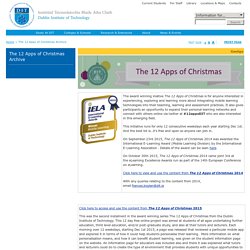
It also gives participants an opportunity to expand their personal learning networks and connect with others online via twitter at #12appsDIT who are also interested in this emerging field. This initiative runs for only 12 consecutive weekdays each year starting Dec 1st. And the best bit is…it’s free and open so anyone can join in. On September 23rd 2015, The 12 Apps of Christmas 2014 was awarded the International E-Learning Award (Mobile Learning Division) by the International E-Learning Association . The 12 Apps of Christmas. The SAMR model (Substitution, Augmentation, Modification, Redefinition), created by Dr.
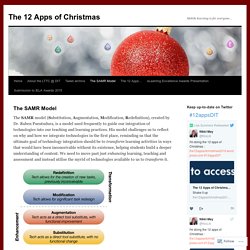
Ruben Puentudura, is a model used frequently to guide our integration of technologies into our teaching and learning practices. His model challenges us to reflect on why and how we integrate technologies in the first place, reminding us that the ultimate goal of technology integration should be to transform learning activities in ways that would have been inconceivable without its existence, helping students build a deeper understanding of content.
We need to move past just enhancing learning, teaching and assessment and instead utilise the myrid of technologies available to us to transform it. Image source: To give a practical example of how a simple activity could be transformed, consider this: Image Source: New Ed Tech and Online Education Developments. A Step by Step Guide to ‘Untethered’ Faculty Development. Rapid E-Learning 101. Rapid elearning can mean many things.
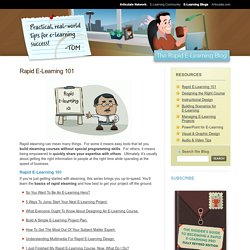
For some it means easy tools that let you build elearning courses without special programming skills. For others, it means being empowered to quickly share your expertise with others. Technology enhanced learning. Flexible pedagogies: new pedagogical ideas. What's Your Memory Style? 5 Ways to Accommodate the Way Your Brain Works - InformED. Not all memory is created equal.

While some of us have detailed, context-dependent accounts of when and where we learned something, others seem to have a reserve of facts in their brain that they can pull from, independent of the original context in which they learned the information. Why does memory differ from person to person in this way, and how does it affect learning? A research team from the Rotman Research Institute at Baycrest Health Sciences is on the path to finding out. The Study “For decades, nearly all research on memory and brain function has treated people as the same, averaging across individuals,” says lead investigator Dr. The study, published online in the journal Cortex, shows for the first time that these different ways of experiencing the past are associated with distinct brain connectivity patterns that may be inherent to the individual, suggesting a life-long “memory trait.” Teaching Content Curation and 20 Resources to Help You Do It - InformED.
At St.
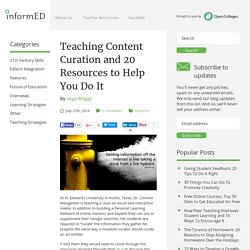
Edward’s University in Austin, Texas, Dr. Here's What Adaptive Technology Is Teaching Us About Learning - InformED. The Backchannel: Giving Every Student a Voice in the Blended Mobile Classroom.
Writing. Flipping. How to Create an Intuitive Design. “The main thing in our design is that we have to make things intuitively obvious,” the founder and former CEO of Apple, Steve Jobs, explained.

We can easily agree that design should be intuitive. We can also easily agree that something is intuitive when we can use it without thinking about it. Making a design intuitive is much tougher. Solving this task requires an understanding of the psychology behind human interaction, specifically how humans come to understand the physical and cultural environment. In this article, you’ll learn the basic psychology behind designing intuitive user interfaces – and you’ll learn how to get started applying it. 10 Alternatives to InfuseLearning for Assessments. Yesterday, it was announced that InfuseLearning, the popular, free online formative assessment tool, will be closing its doors for good on April 3, 2015.

What is Genius Hour? - Introduction to Genius Hour in the Classroom. Critical Thinking Lessons. What I Bring to UX From … Psychology. How does one end up in UX after counseling delinquent girls and brain injured individuals?

This question is one I am asked frequently once people find out the somewhat unorthodox route I took towards my career in UX. With some explanation, the connection between the two areas becomes much clearer and there is greater understanding for how my background in psychology has laid the groundwork for a career in UX. Others Who Have Followed A Similar Path It is difficult to think of the connection between psychology and UX without thinking of Donald Norman, as he is the person who set the stage for incorporating aspects of Cognitive Psychology within Interaction Design, one area of User Experience. Certain basic principles of cognitive psychology provide grounding for interaction design. From Wikipedia Susan Weischenk, “The Brain Lady” also comes from a background in psychology. Storyboards Are Really Very Simple.
A storyboard can easily be created by hand.
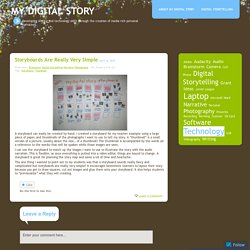
I created a storyboard for my teacher example using a large piece of paper, and thumbnails of the photographs I want to use to tell my story. A “thumbnail” is a small version of a picture, usually about the size… of a thumbnail! The thumbnail is accompanied by the words (or a reference to the words) that will be spoken while those images are seen. Resources - Elearning Update 2016. Welcome to our Resources page. On this page we will share links to other webistes that have good information about the Theory, Trends and Techniques of Elearning and Blended Learning. Please feel free to leave us a comment, and to propose other links. After the introduction, which provides links to sites about the history and theory of instructional design, this page will follow the traditional "ADDIE" steps of instructional design as the organising principle. eLearning Industry - Post your eLearning article. At eLearning Industry you will find the best collection of eLearning articles, eLearning concepts, eLearning software, and eLearning resources.
Make Your eLearning Content Addictive - eLearning Industry. The Benefits of BYOD for m-Learning - eLearning Industry. In the eLearning Guild Research Report last year, Mobile Learning: The Time is Now, 98 percent of Guild members reported owning at least one personal mobile device. Over 70 percent reported using their personal devices to accomplish work related tasks.
The BYOD movement has grown in recent years despite some organizations’ hesitation to allow employees all the freedoms that go along with using personal devices and their associated risks. With the importance of maintaining corporate security, many employers are successfully balancing freedom and control of personal devices for work related duties. Positive Work EnvironmentToday, people are extremely attached to their personal devices. The Who, What, When and Why of Mobile Learning - eLearning Industry. 8 Steps To Create and Develop an Effective Mobile Training Strategy - eLearning Industry. 7 Tips To Repurpose eLearning Content for Mobile Learning - eLearning Industry. 5 Tips To Develop Mobile Learning Assessments - eLearning Industry. Mobile learning can take place anywhere, anytime, thanks to mobile devices. Learners can now access educational resources whenever they find most convenient and engage in powerful mobile learning experiences while on-the-go.
However, mobile learning courses can only be truly effective if there is a way to assess learners knowledge and determine whether they have actually absorbed and retained the subject matter. Here are some helpful tips to develop mobile learning assessments for your next mobile learning course. Conclude each unit or module with an assessment. 10 Tips for Teachers Using Twitter. Instagram: Document and Share Grammar Gaffes.